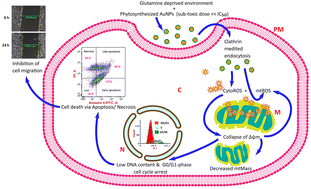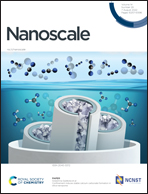Low-dose exposure to phytosynthesized gold nanoparticles combined with glutamine deprivation enhances cell death in the cancer cell line HeLa via oxidative stress-mediated mitochondrial dysfunction and G0/G1 cell cycle arrest
Abstract
Cancer cells use nutrients like D-glucose (Glc) and L-glutamine (Q) more efficiently for their development. This increased nutritional dependency of malignant cells has been commonly employed in various in vitro and in vivo models of anticancer therapies. This study utilized a combination of a low dose (25 μg mL−1) of S2, a phytosynthesized gold nanoparticle (AuNP) that was previously proven to be non-toxic, and deprivation of extracellular glutamine as an anticancer strategy in the human cervical cancer cell line HeLa. We discovered that 24 h Q deprivation led to a less significant decrease in the viability of HeLa cells while a low dose of S2 caused a non-significant reduction in the viability of HeLa cells. However, combining these two treatments resulted in highly significant inhibition of cell growth, as measured by the MTT test and morphological examination. Glutamine starvation in HeLa cells was found to induce cellular uptake of S2 via clathrin-mediated endocytosis, thus facilitating the improved antitumor effects of the combined treatment. Flow cytometry-based assays using fluorescent probes H2DCFDA and MitoSOX Red confirmed that this combination therapy involved the development of oxidative stress conditions owing to a surplus of cytosolic reactive oxygen species (cytoROS) and mitochondrial superoxide (mtSOX) generation. Furthermore, the investigated combinatorial treatment also indicated mitochondrial inactivity and disintegration, as evidenced by the drop in the mitochondrial membrane potential (Δψm) and the decrease in the mitochondrial mass (mtMass) in a flow-cytometric assay utilizing the probes. Tetramethylrhodamine ethyl ester and MitoTracker Green FM, respectively. Cell cycle arrest in the G0/G1 phase, induction of cell death via apoptosis/necrosis, and inhibition of migration capacities of HeLa cells were also seen after the combined treatment. Thus, this research provides insight into a new combinatorial approach for reducing the dose of nanoparticles and increasing their efficacy to better inhibit the growth of human cervical cancer cells by leveraging their extracellular glutamine dependence.

- This article is part of the themed collection: Design and function of materials nanoarchitectonics


 Please wait while we load your content...
Please wait while we load your content...